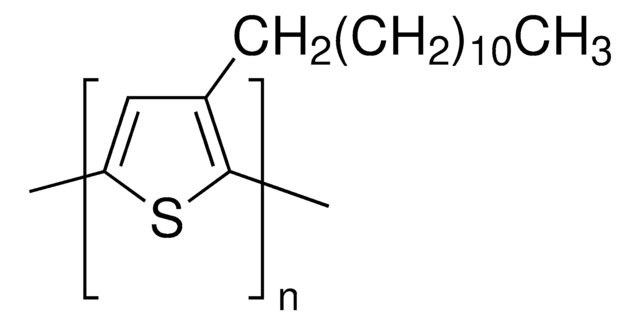900550
Poly(3-hexylthiophene-2,5-diyl)
regioregular, average Mw 50,000-75,000
Synonym(s):
P3HT
About This Item
Recommended Products
description
Metal purity: Mg: ≤100 ppm
Ni: ≤100 ppm
Regioregularity: ≥90%
Quality Level
form
solid
mol wt
average Mw 50,000-75,000
InChI
1S/C12H20S/c1-4-5-6-7-8-12-9-10(2)13-11(12)3/h9H,4-8H2,1-3H3
InChI key
DUFPJSOXRHVDOV-UHFFFAOYSA-N
Looking for similar products? Visit Product Comparison Guide
Related Categories
General description
Application
Storage Class Code
11 - Combustible Solids
WGK
WGK 3
Flash Point(F)
Not applicable
Flash Point(C)
Not applicable
Certificates of Analysis (COA)
Search for Certificates of Analysis (COA) by entering the products Lot/Batch Number. Lot and Batch Numbers can be found on a product’s label following the words ‘Lot’ or ‘Batch’.
Already Own This Product?
Find documentation for the products that you have recently purchased in the Document Library.
Customers Also Viewed
Articles
Professor Shinar highlights low-cost, disposable sensor configurations in organic and hybrid electronics for healthcare applications.
Small molecular weight organic semiconductors are promising for flexible transistor applications in next-gen soft electronics.
Intrinsically stretchable active layers for organic field-effect transistors (OFET) are discussed. Polymer structural modification & post-polymerization modifications are 2 methods to achieve this.
Next generation solar cells have the potential to achieve conversion efficiencies beyond the Shockley-Queisser (S-Q) limit while also significantly lowering production costs.
Related Content
Organic electronics utilizes organic conductors and semiconductors for applications in organic photovoltaics, organic light-emitting diodes, and organic field-effect transistors.
Our team of scientists has experience in all areas of research including Life Science, Material Science, Chemical Synthesis, Chromatography, Analytical and many others.
Contact Technical Service










![[6,6]-Phenyl C61 butyric acid methyl ester >99.9%](/deepweb/assets/sigmaaldrich/product/structures/359/221/d990c746-0960-4c69-bf76-fe09b193824d/640/d990c746-0960-4c69-bf76-fe09b193824d.png)

